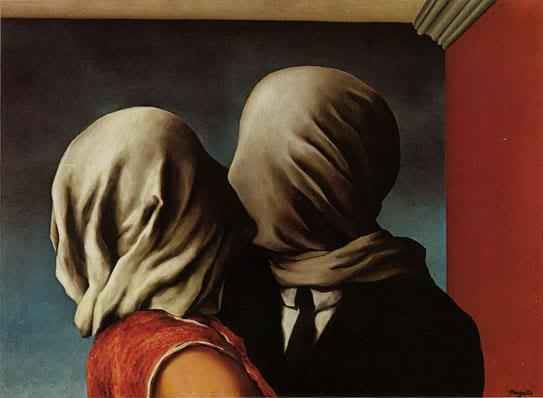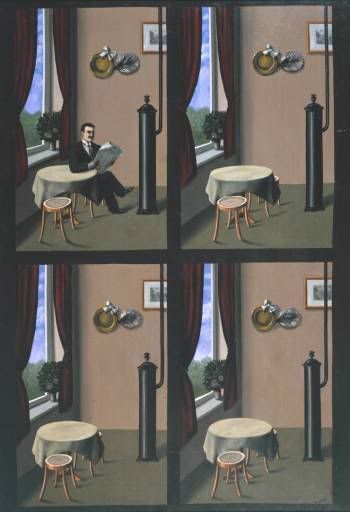Topics Covered:
Platonic thought's relevance to shoegaze, Romantic poetry, Surrealism, and the filmography of Vincent Gallo

Play-doh Plato. A good pun, but hardly Ideal.
Platonic thought's relevance to shoegaze, Romantic poetry, Surrealism, and the filmography of Vincent Gallo

Play-doh Plato. A good pun, but hardly Ideal.
Though perhaps a bit outmoded as a pragmatic worldview, Platonic Idealism has been remarkably resilient in the realm of art, manifesting itself continually throughout history in practically every medium and genre. In its original sense it referred to the notion that specific objects in observable reality are merely imperfect reflections of an eternal Ideal which exists in the realm of ideas as the standard by which we mentally apprehend the object's essence. To paraphrase Wikipedia's practical example: the tree in your back yard has a few dead branches and a pair of initials carved into it. These imperfections differentiate it from the Ideal tree which you envision in your mind when you think of what is meant by the word "tree". Perhaps a bit hard to believe, but as a concept it could justifiably be considered the basis of pretty much every post-modern, "meta" creative gesture you hold dear since it is so bound up in the process of creation. Art begins in the realm of imagination where it is theoretically perfect, in a sense Ideal, but as a means of communication it is inextricably linked to the real, limited by the flawed materials which compose it, etc., and thus it becomes an imperfect reflection of itself. Any piece which highlights its own inability to effectively convey its message or, even more elaborately, indicates a message but refuses to engage it explicitly for fear that doing so would distort its meaning owes a great debt to good, old-fashioned Platonic Idealism.
The allure of this dynamic was first made apparent to me through this song:
My intense love for "Sometimes" is almost entirely based on its deliberate refusal to deliver on the emotional catharsis it promises. The (discernible) lyrics are charged with romantic expectancy which is never resolved. The synth-y/organ-y strain builds and rises, but its volume never rises above the general murmur. It psychs me out every time and yet I'm never disappointed because, as corny as it may sound, I'm fairly certain the Ideal climax I imagine is better than anything Kevin Shields could have actually achieved (no offense, man.)
Speaking of the greatest songs never played you couldn't ask for a more canonical example than the second stanza of John Keats' "Ode on a Grecian Urn":
"Heard melodies are sweet, but those unheard
Are sweeter: therefore, ye soft pipes, play on;
Not to the sensual ear, but, more endear'd,
Pipe to the spirit ditties of no tone:
Fair youth, beneath the trees, thou canst not leave
Thy song, nor ever can those trees be bare;
Bold Lover, never, never canst thou kiss,
Though winning near the goal - yet, do not grieve;
She cannot fade, though thou hast not they bliss,
For ever wilt thou love, and she be fair!"
These lines refer, of course, to the figures depicted on the titular urn of Greek origin, each frozen in time at a point before the completion of the action which gives their (real or imagined) life meaning. By being preserved in an Ideal, heroic posture they become eternal, fixed representations of abstractions, and thus are free from the stain of mundanity and the inevitable decay of mortals who are too unstable to function as signifiers of anything greater than themselves. An appropriate sentiment for a poet whose premature death did so much to cement his fame. Though the idea that an artist's imagination could somehow grant him access to the Ideal and this action's relationship to the real objects on which it is based are fairly common themes among the Romantic poets (equally famous examples of it are readily apparent in the work of Coleridge and Wordsworth) Keats stands out in particular as being a supreme champion of the mind and its power to create new realities through art, uncompromised by their transition. He famously wrote in a letter to Benjamin Bailey: "The Imagination may be compared to Adam's dream--he awoke and found it truth." Perhaps it never occurred to him since it had endured so long that one day his urn might break.
If the Ideal was somewhat coded in the imagery of Romantic poetry, it couldn't get more overt than the Surrealist art movement which attempted to bring subconscious, prerational thought directly into the real world. Perhaps a bit counterintuitively, practitioners often tried to do this while utilizing materials and established formats which were already endowed with their connotations. Whether or not that nullifies their aim of making a "meaningless" work, an Ideal visual mystery which raises questions but doesn't provide enough clues to arrive at a definitive answer, I couldn't really say. Anyhow, one thing that is readily apparent is that a particular Surrealist's success on both a business and philosophical level is often directly linked to their ability to keep people guessing. Sometimes this might come off as "gimmicky" in a "dude, check it out the landscape is actually, like, a face cuz, like, we're all a part of nature, right?" kind of way, but in the work of someone like René Magritte even fairly straightforward images present a lot of intriguing details to puzzle over.
If the Ideal was somewhat coded in the imagery of Romantic poetry, it couldn't get more overt than the Surrealist art movement which attempted to bring subconscious, prerational thought directly into the real world. Perhaps a bit counterintuitively, practitioners often tried to do this while utilizing materials and established formats which were already endowed with their connotations. Whether or not that nullifies their aim of making a "meaningless" work, an Ideal visual mystery which raises questions but doesn't provide enough clues to arrive at a definitive answer, I couldn't really say. Anyhow, one thing that is readily apparent is that a particular Surrealist's success on both a business and philosophical level is often directly linked to their ability to keep people guessing. Sometimes this might come off as "gimmicky" in a "dude, check it out the landscape is actually, like, a face cuz, like, we're all a part of nature, right?" kind of way, but in the work of someone like René Magritte even fairly straightforward images present a lot of intriguing details to puzzle over.
Though none of these images is beyond the realm of possibility they somehow come off as fantastical. In each piece the focus is simultaneously evident and obscured and so the viewer's attention is arrested indefinitely until their mind can create an explanation which can be plausible (the man simply finished the newspaper and went about his day) or implausible (he vanished, never to return) so long as it creates a justification for their initial interest. For me, Magritte's work come closest to achieving an Ideal mystery because it recycles the imperfect manifestation of the artist's thoughts back into the mind of the audience where it takes on its surreal qualities.
NOTE: this section will contain movie spoilers.
Multi-functional and fascinating though it may be, Platonic Idealism and its offshoots can be restrictive in their own way and just as much art has been produced in refutation of them as in acceptance. Vincent Gallo's Buffalo '66 stands out as an excellent film which, on one level, functions as literal rejection of Idealism. The protagonist, Billy Brown (Gallo), wants so badly to create an Ideal image of himself that he abducts Layla (Christina Ricci) so he can put up a front as an embodiment of the American Dream (government job, a beautiful wife, the promise of offspring) for his parents. Hilarious hijinx ensue:
Lurking grimly in the background of this ridiculousness is Billy's equally Idealized plot for revenge against the former NFL kicker whom he blames for the sad state of affairs in his life. However, when he is about to perform his sinister deed he envisions the practical results of his action: two meaningless deaths and no one to appreciate his "glorious" gesture. Ultimately, he opts for a more nihilistic outlook, giving supreme importance to the real relationship he has cultivated with Layla rather than going through with the absurdly myopic vendetta he has fantasized about for so long. While reserved in its aspirations for greatness it comes off as feel-good in the end, so even a hardcore Idealist can come out of it feeling like a winner.



No comments:
Post a Comment